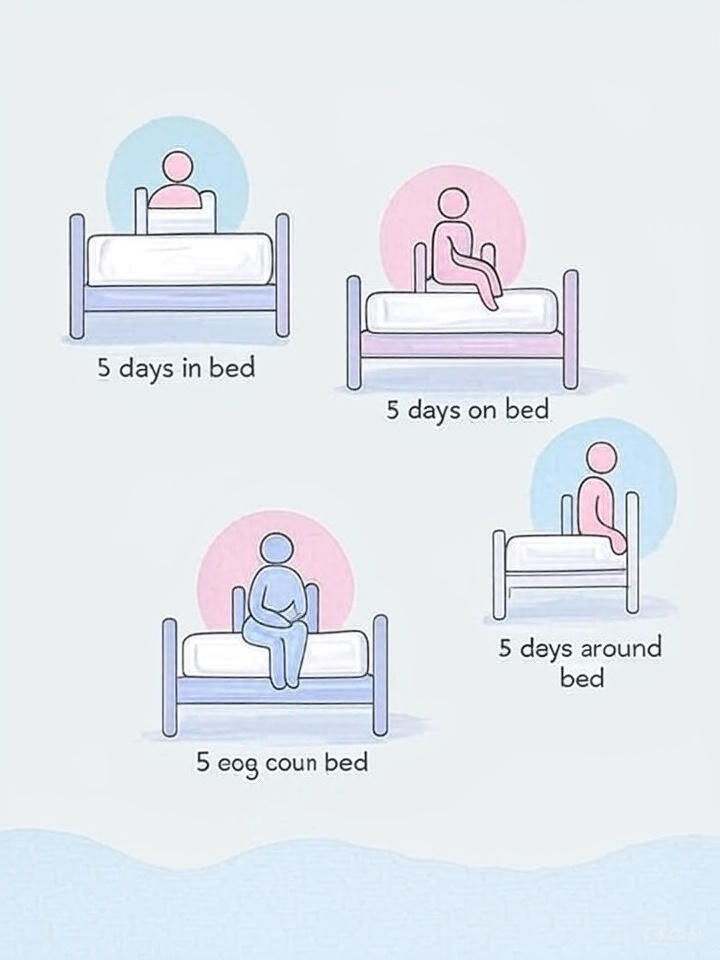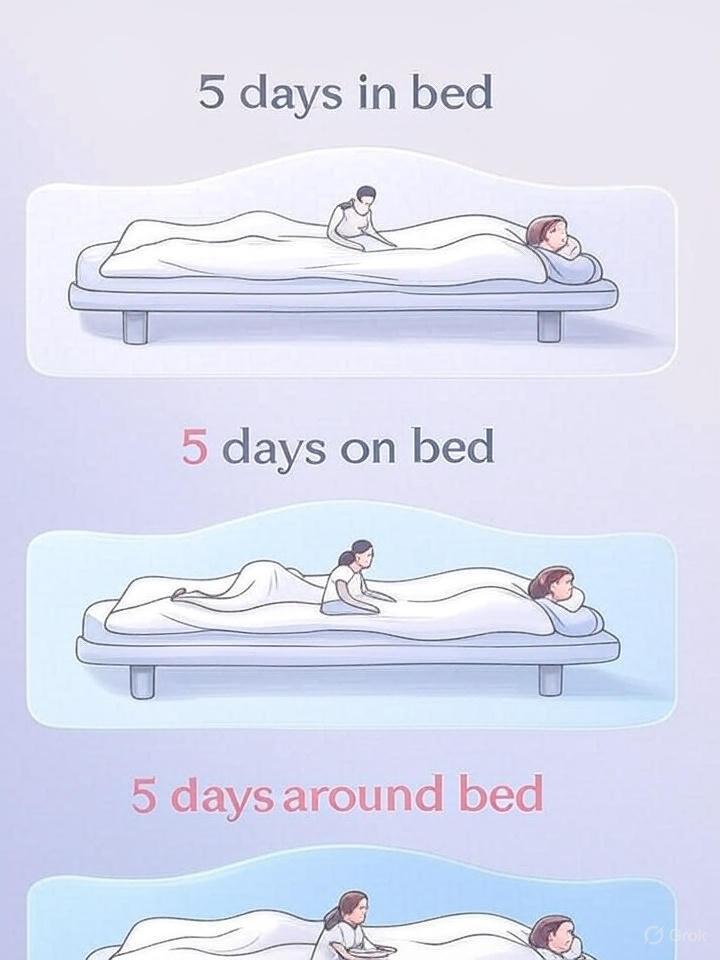The Complete Guide to the 5-5-5 Postpartum Rule: Evidence-Based Recovery for New Mothers
The fourth trimester – those crucial first 12 weeks after birth – represents one of the most transformative periods in a woman’s life. Yet despite its importance, postpartum recovery often lacks the structured guidance that pregnancy receives. Enter the 5-5-5 postpartum rule: a time-tested framework that’s gaining renewed attention from healthcare professionals and new mothers worldwide.
This comprehensive guide explores everything you need to know about implementing the 5-5-5 rule, from its historical origins to modern adaptations for different birth experiences.
Understanding the 5-5-5 Postpartum Rule

The 5-5-5 postpartum rule breaks down the first 15 days after birth into three distinct phases:
- 5 days “in bed” – Complete rest and recovery
- 5 days “on bed” – Light activity while maintaining rest
- 5 days “around bed” – Gradual return to normal activities
This structured approach recognizes that recovery isn’t linear and provides a framework that adapts to your body’s natural healing timeline.
Historical Context and Modern Relevance
The 5-5-5 rule draws inspiration from traditional postpartum practices found across cultures. Similar to the Chinese practice of zuoyuezi (sitting the month) and the Latin American tradition of la cuarentena (the quarantine), these approaches prioritize rest and community support during the vulnerable postpartum period.
According to research published in the Journal of Midwifery & Women’s Health, structured postpartum recovery periods significantly improve both physical and mental health outcomes for new mothers.
Phase 1: The First 5 Days “In Bed”
Complete Rest and Healing Focus
The initial five days require maximum rest to support your body’s immediate healing needs. This phase isn’t about being bedridden but rather prioritizing horizontal rest and minimal activity.
Key activities include:
- Nursing and bonding with your baby
- Eating nutritious, easily digestible meals
- Accepting help with household tasks
- Focusing on hydration and basic hygiene
Physical Recovery Priorities
During this phase, your body undergoes significant changes:
- Uterine involution: Your uterus begins contracting back to its pre-pregnancy size
- Lochia management: Understanding normal vs. concerning bleeding patterns
- Perineal or incision healing: Proper wound care and pain management
- Hormonal fluctuations: Managing the dramatic shift in pregnancy hormones
The American College of Obstetricians and Gynecologists emphasizes that adequate rest during the immediate postpartum period significantly reduces complications and supports faster recovery.
Nutrition for Healing
Proper nutrition during the first five days accelerates healing and supports breastfeeding. Focus on:
- Protein-rich foods: Essential for tissue repair
- Iron-rich sources: Replenishing stores lost during delivery
- Hydrating foods: Soups, broths, and water-rich fruits
- Anti-inflammatory options: Omega-3 fatty acids and antioxidant-rich vegetables
For convenient nutrition options that support recovery, consider incorporating nutrient-dense snacks that provide sustained energy without requiring preparation.
Phase 2: Days 6-10 “On Bed”

Gradual Activity Introduction
The second phase allows for slightly increased activity while maintaining a rest-focused approach. Think of this as “active rest” – you’re still prioritizing recovery but can engage in light activities.
Appropriate activities:
- Short walks around your home
- Light stretching or gentle yoga
- Sitting up for longer periods during meals
- Taking brief showers independently
5-5-5 Rule After C-Section Modifications
For mothers recovering from cesarean delivery, the “on bed” phase requires additional considerations:
- Avoid lifting: Nothing heavier than your baby
- Incision care: Monitor for signs of infection or complications
- Movement modifications: Use log-rolling technique when getting up
- Extended rest periods: May need to extend each phase by 2-3 days
The Mayo Clinic recommends avoiding stairs and driving during this period to prevent complications.
Building Your Support Network
This phase is crucial for establishing your partner role in 5-5-5 postpartum care:
Partner responsibilities:
- Meal preparation and grocery shopping
- Household management and cleaning
- Visitor coordination and boundary setting
- Emotional support and encouragement
- Night feeding assistance when possible
Mental Health and Emotional Wellness
The 6-10 day period often coincides with the “baby blues” – a normal response to hormonal changes affecting up to 80% of new mothers. However, it’s important to monitor for signs of more serious conditions.
Normal baby blues symptoms:
- Mood swings and tearfulness
- Anxiety about baby care
- Difficulty sleeping when baby sleeps
- Feeling overwhelmed
When to seek help:
- Symptoms lasting beyond two weeks
- Difficulty bonding with baby
- Thoughts of self-harm or harming baby
- Severe anxiety or panic attacks
Phase 3: Days 11-15 “Around Bed”
Gradual Independence Building
The final phase focuses on slowly rebuilding independence while maintaining realistic expectations about energy levels and capacity.
Progressive activities:
- Household tasks in short bursts
- Brief outings for appointments
- Increased social interaction
- Light meal preparation
Postpartum Mental Health Schedule
Implementing a structured approach to mental health during this phase proves crucial for long-term wellbeing:
Daily check-ins:
- Morning mood assessment (1-10 scale)
- Energy level tracking
- Sleep quality evaluation
- Support system utilization
Weekly goals:
- One meaningful social interaction
- One activity for personal enjoyment
- Progress celebration (however small)
- Professional support evaluation
Real-Life Success Stories and Testimonials
Sarah’s C-Section Recovery
“Following my cesarean delivery, I was terrified about recovery. The 5-5-5 rule gave me permission to rest without guilt. By day 10, I felt stronger than I had after my first delivery when I tried to ‘bounce back’ too quickly. The structured approach helped my partner know exactly how to support me.”
Maria’s Experience with Twins
“With twins, the 5-5-5 rule required modifications, but the framework kept me sane. I extended each phase by three days and enlisted additional family support. Having clear phases helped everyone understand what I needed and when.”
Jennifer’s Mental Health Journey
“The rule wasn’t just about physical recovery – it gave me a framework for emotional healing too. Knowing I had ‘permission’ to rest helped me process the birth experience and adjust to motherhood without pressure.”
Best Postpartum Kits for 5-5-5 Implementation
Essential Items for Each Phase
Phase 1 Kit (Days 1-5):
- Comfortable nursing-friendly pajamas
- Postpartum recovery pads and underwear
- Nipple cream and breastfeeding supplies
- Healthy snacks and water bottle
- Entertainment (books, tablets, magazines)
Phase 2 Kit (Days 6-10):
- Comfortable loungewear for light activity
- Gentle skincare products
- Light exercise equipment (resistance bands)
- Meal prep containers
- Baby carrier for short walks
Phase 3 Kit (Days 11-15):
- Transitional clothing that fits comfortably
- Energy-supporting supplements (with doctor approval)
- Organizational tools (calendars, apps)
- Self-care items (bath products, aromatherapy)
Professional Support Integration
When to Involve Healthcare Providers
The 5-5-5 rule complements, not replaces, professional medical care:
Scheduled check-ins:
- 48-72 hours post-discharge
- 7-10 days for incision or healing assessment
- 2-3 weeks for overall recovery evaluation
- 6-8 weeks for final postpartum examination
Doula and Lactation Support
Professional postpartum support can significantly enhance your 5-5-5 experience:
Postpartum doulas provide:
- Practical household assistance
- Breastfeeding guidance
- Emotional support and education
- Newborn care instruction
Lactation consultants offer:
- Feeding assessment and troubleshooting
- Milk supply optimization
- Pump training and support
- Return-to-work preparation
Cultural Adaptations and Variations
Global Postpartum Practices
The 5-5-5 rule aligns with traditional practices worldwide:
Chinese Zuoyuezi (Sitting the Month):
- 30-day recovery period
- Emphasis on “warming” foods
- Restricted activity and visitors
- Community support system
Latin American La Cuarentena:
- 40-day recovery period
- Traditional herbal remedies
- Family-centered support
- Gradual activity resumption
According to anthropological research, cultures with structured postpartum confinement periods show lower rates of postpartum depression and faster physical recovery.
Common Challenges and Solutions
Challenge 1: Guilt About Resting
Many mothers struggle with feeling “lazy” or unproductive during recovery.
Solution: Reframe rest as active healing. Your body is performing the equivalent of intense physical work during recovery.
Challenge 2: Partner Resistance
Some partners may not understand the need for extended support.
Solution: Share educational resources and involve them in planning. Clear communication about needs and expectations prevents misunderstandings.
Challenge 3: Older Children’s Needs
Balancing recovery with existing children’s needs requires creativity.
Solution: Involve children in age-appropriate ways. Create special “quiet time” activities and enlist extended family support.
Challenge 4: Work Pressure
Pressure to return to work or productivity can undermine recovery.
Solution: Set clear boundaries and communicate your recovery plan to employers. Research shows that proper postpartum recovery reduces long-term health costs and improves job performance.
Frequently Asked Questions
Can I leave the house during the 5-5-5 rule?
Brief, necessary outings (medical appointments, pharmacy visits) are acceptable, but avoid unnecessary errands or social visits during the first 10 days. The rule prioritizes rest over social obligations.
What if I have medical complications?
Any medical concerns should be addressed immediately with your healthcare provider. The 5-5-5 rule may need modification based on individual circumstances, surgical complications, or health conditions.
How do I handle visitors during recovery?
Set clear boundaries about visiting hours and duration. Consider designating specific days for visitors and asking them to help with household tasks rather than expecting entertainment.
When should I be concerned about my mental health?
Seek professional help if you experience persistent sadness, anxiety, thoughts of self-harm, or difficulty bonding with your baby. These symptoms may indicate postpartum depression or anxiety disorders requiring treatment.
Returning to Work: Planning and Support
Gradual Transition Strategies
For mothers planning to return to work, the 5-5-5 rule provides a foundation for gradual transition:
Weeks 3-4: Begin thinking about work logistics without pressure Weeks 5-8: Start occasional work-related communication Weeks 9-12: Implement trial runs for childcare and routine
Workplace Accommodations
Under the Family and Medical Leave Act, eligible employees can take up to 12 weeks of unpaid leave. Many employers offer additional accommodations:
- Flexible scheduling
- Gradual return-to-work programs
- Lactation support facilities
- Work-from-home options
Long-Term Benefits and Outcomes
Physical Health Improvements
Research demonstrates that structured postpartum recovery periods lead to:
- Reduced risk of postpartum complications
- Improved breastfeeding success rates
- Better pelvic floor recovery
- Lower rates of chronic pain conditions
Mental Health Benefits
The psychological benefits of following the 5-5-5 rule include:
- Reduced postpartum depression rates
- Improved mother-infant bonding
- Better partner relationship satisfaction
- Increased confidence in mothering abilities
Family System Benefits
Families who implement structured recovery periods report:
- Clearer role definitions and expectations
- Improved communication patterns
- Stronger support networks
- Better adjustment to family changes
Creating Your Personal 5-5-5 Plan
Assessment and Customization
Before implementing the rule, assess your individual needs:
Personal factors:
- Birth experience and complications
- Previous postpartum experiences
- Available support systems
- Cultural background and preferences
Practical considerations:
- Housing arrangements
- Financial resources
- Childcare needs
- Work requirements
Implementation Timeline
Pre-birth preparation:
- Discuss the plan with your partner and support system
- Prepare meals and household organization
- Arrange professional support if needed
- Set up recovery space and supplies
Post-birth execution:
- Communicate your needs clearly
- Accept help gracefully
- Modify the plan as needed
- Document your experience for future reference
Resources for Extended Support
Online Communities and Apps
Digital support can complement in-person help:
- Postpartum support groups
- Breastfeeding apps and communities
- Mental health tracking tools
- Meal planning and delivery services
Professional Resources
Consider these professional support options:
- Postpartum doulas
- Lactation consultants
- Mental health therapists specializing in perinatal care
- Nutritionists familiar with postpartum needs
Educational Materials
Continue learning about postpartum recovery through:
- Evidence-based books and articles
- Webinars and online courses
- Hospital and clinic resources
- Peer support groups
Conclusion: Your Recovery, Your Rules
The 5-5-5 postpartum rule provides a flexible framework for recovery that honors both traditional wisdom and modern understanding of postpartum needs. Remember that this guideline should be adapted to your individual circumstances, cultural background, and personal preferences.
Recovery isn’t a race – it’s a process that deserves patience, support, and respect. By following the principles of the 5-5-5 rule while remaining flexible to your unique needs, you’re setting the foundation for healthy motherhood and family life.
Whether you’re preparing for your first baby or reflecting on previous postpartum experiences, the 5-5-5 rule offers a roadmap for intentional, supported recovery that honors both your physical healing and emotional wellbeing.
Remember: seeking help isn’t a sign of weakness – it’s a sign of wisdom. Your recovery matters, your needs are valid, and taking time to heal properly benefits not just you, but your entire family.
Ready to implement your 5-5-5 recovery plan? Start by discussing this framework with your healthcare provider and support system. Your postpartum journey deserves the same attention and care you gave to your pregnancy – the 5-5-5 rule can help you achieve just that.





Pingback: Can Early Teething Alone Mean My Child Has Autism? - Snapspeak